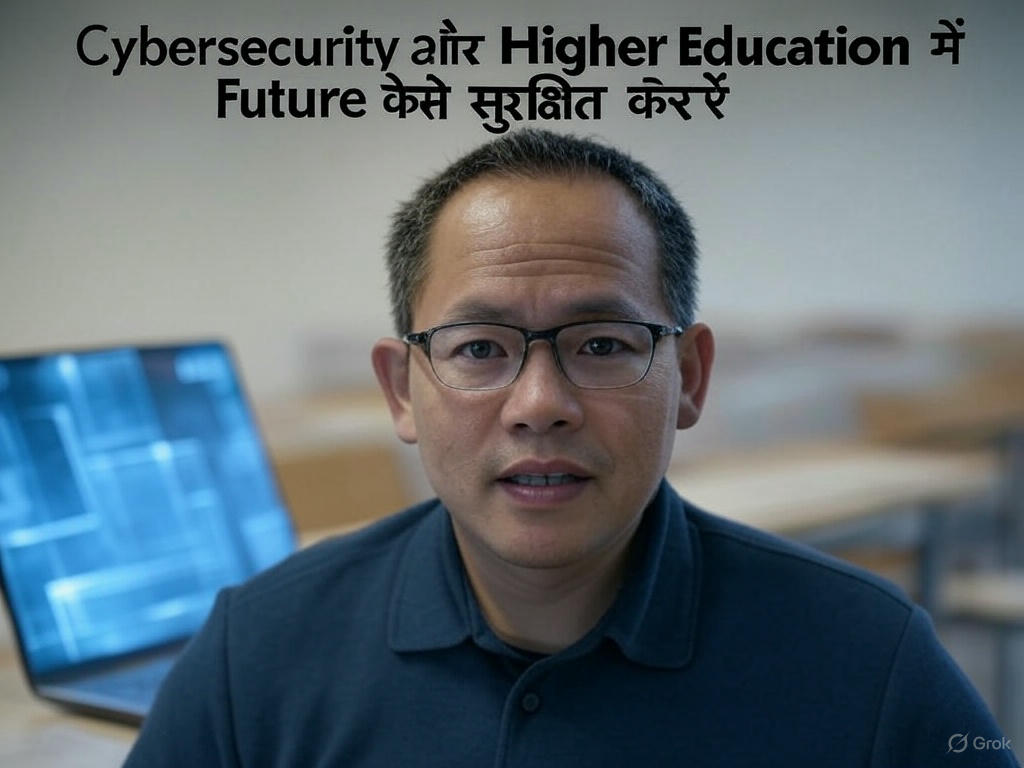Cybersecurity और Higher Education में Future कैसे सुरक्षित करें?
Higher education institutions (जैसे कॉलेज, यूनिवर्सिटी) आज डिजिटल युग में तेजी से आगे बढ़ रहे हैं। ऑनलाइन क्लासेस, रिसर्च डेटा, और स्टूडेंट रिकॉर्ड्स के साथ-साथ साइबर खतरों का जोखिम भी बढ़ रहा है। 2025 में cybersecurity higher education के लिए एक critical priority बन गई है, क्योंकि डेटा ब्रीच, रैनसमवेयर, और फिशिंग अटैक्स बढ़ते जा रहे हैं।
1. Cybersecurity Threats को समझें
Higher education में cybersecurity का future सुरक्षित करने के लिए पहले मौजूदा खतरों को समझना जरूरी है।
- Common Threats:
- Ransomware: Institutions को lock कर ransom मांगा जाता है।
- Phishing: स्टूडेंट्स और स्टाफ को फर्जी emails से trap किया जाता है।
- Data Breaches: Sensitive डेटा (research, student info) चोरी होता है।
- क्यों टारगेट? Open networks, valuable research, और budget constraints।
- Digital Tool: X पर latest cyber threats ट्रैक करें।
Threats समझें तो सही strategy बनाएं।
2. Higher Education में Cybersecurity का Importance
Higher education institutions डिजिटल प्लेटफॉर्म्स (LMS, cloud storage) पर निर्भर हैं। Cybersecurity इनका backbone है।
- क्यों जरूरी?
- Student data (personal, financial) की सुरक्षा।
- Research integrity और intellectual property की रक्षा।
- Reputation और trust बनाए रखना।
- Impact: एक breach से लाखों का नुकसान और enrollment drop।
- Goal: Future-ready, secure campuses।
Cybersecurity से institution का भविष्य सुरक्षित करें।
3. Future Trends in Cybersecurity (2025)
2025 में cybersecurity trends higher education को shape करेंगे। इनका इस्तेमाल कर future सुरक्षित करें।
a) AI और Machine Learning
- Role: Threat detection, anomaly identification।
- Use: AI tools से phishing emails block करें।
- Edge: Fast response, predictive security।
b) Zero Trust Architecture
- क्या है? हर user/device को verify करना।
- Use: Campus Wi-Fi पर strict access controls।
- Benefit: Insider threats कम होंगे।
c) Cloud Security
- Trend: Hybrid और multi-cloud adoption।
- Tool: AWS, Azure के security features।
- Edge: Data breaches से बचाव।
d) Quantum Threats
- Future Risk: Encryption को तोड़ने की क्षमता।
- Solution: Quantum-resistant algorithms अपनाएं।
- Benefit: Long-term डेटा सुरक्षा।
Trends के साथ चलें तो future safe रहेगा।
4. Digital Tools और Strategies
Higher education में cybersecurity को मजबूत करने के लिए digital tools और strategies अपनाएं।
- Tools:
- Firewalls: Network protection।
- Endpoint Security: Devices (laptops, phones) secure करें।
- SIEM Systems: Real-time threat monitoring।
- Strategies:
- Regular backups: Ransomware से बचाव।
- Multi-Factor Authentication (MFA): Login security।
- Penetration Testing: Weaknesses ढूंढें।
- Tip: Free tools (Google Authenticator) से शुरू करें।
Digital solutions से campus सुरक्षित करें।
5. Faculty और Students को Train करें
Cybersecurity में human error सबसे बड़ी कमजोरी है। Training से इसे कम करें।
- क्या करें?
- Workshops: Phishing पहचान सिखाएं।
- Online Courses: Basic cyber hygiene।
- Tools: Coursera, Udemy पर free cybersecurity modules।
- Example: “Strong password kaise banaye” सिखाएं।
- Edge: Aware staff/students = कम risks।
Training से cybersecurity culture बनाएं।
6. Research Data की सुरक्षा
Higher education में research डेटा (medical, tech) hackers के लिए prime target है।
- कैसे सुरक्षित करें?
- Encryption: डेटा को unreadable बनाएं।
- Secure Storage: Cloud पर access controls।
- Backup: Offline copies रखें।
- Tool: VeraCrypt (free encryption)।
- Benefit: Intellectual property safe रहेगा।
Research को प्रोटेक्ट कर future innovation बचाएं।
7. Budget और Resources का Management
Higher education में अक्सर cybersecurity के लिए budget कम होता है। Digital skills से इसे optimize करें।
- Approach:
- Free Tools: Open-source software (Wireshark)।
- Grants: Government cybersecurity funding।
- Prioritize: High-risk areas (student records) पहले।
- Edge: Low cost में high security।
Smart budgeting से future सुरक्षित करें।
8. Collaboration और Networking
Cybersecurity में अकेले लड़ना मुश्किल है। Higher education institutions को collaborate करना चाहिए।
- क्या करें?
- Share Best Practices: Other universities से सीखें।
- Join Forums: EDUCAUSE cybersecurity groups।
- Digital Tool: LinkedIn पर cybersecurity experts से connect करें।
- Benefit: Collective defense strong होगी।
Collaboration से security बढ़ाएं।
9. Indian Context में Cybersecurity
India में higher education का डिजिटल transformation तेज है, लेकिन cybersecurity पीछे है।
- Challenges:
- Legacy Systems: पुराने networks में vulnerabilities।
- Awareness Gap: स्टूडेंट्स/स्टाफ untrained।
- Solutions:
- IITs/NITs से benchmarks लें।
- Government Schemes: Cyber Swachhta Kendra यूज करें।
- Scope: 2025 में डेटा ब्रीच रोकने की जरूरत।
India-specific strategy से future safe करें।
10. Practical Steps for Secure Future
यहां एक actionable plan है:
- Week 1: Threats assess करें, digital tools (MFA) setup करें।
- Month 1: Faculty/students को basic training दें।
- Month 2-3: Network audit करें, encryption लागू करें।
- Month 4: Mock cyber attack simulate करें, gaps fix करें।
- Ongoing: Monthly updates, online resources ट्रैक करें।
6 months में institution secure हो सकता है।
Challenges और Solutions
- Problem: Budget की कमी।
- Solution: Free tools और grants यूज करें।
- Problem: Technical expertise न हो।
- Solution: Online courses से staff train करें।
- Problem: Resistance to change।
- Solution: Awareness campaigns चलाएं।
हर challenge का digital जवाब ढूंढें।
Conclusion
Cybersecurity और higher education का future सुरक्षित करना 2025 में एक जरूरत बन गया है। AI, zero trust, और cloud security जैसे trends को अपनाएं। Digital tools, training, और collaboration से institutions को protect करें। सही strategy से न सिर्फ डेटा, बल्कि reputation और trust भी बचेगा। Koi specific threat ya tool ke bare mein janna ho to mujhe batayein—main help karunga!
Best of luck for a secure future!
